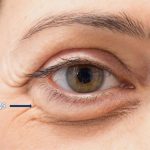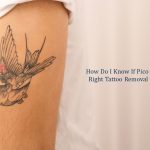Much advancement has been made in the field of plastic surgery, and now, both surgical and non-surgical nose enhancement treatment options are available for addressing cosmetic concerns. The same is the case with surgical nose jobs, apart from the fact that they can also address medical concerns such as breathing issues. Where these advancements have opened many doors of treatment, they have also created confusion among people about which treatment option is better for them.
Are you considering to undergo a nose job but are feeling unsure about whether to choose a non-surgical treatment or a surgical one? This article will help you decide the right treatment for you as it gives a detailed comparison between different aspects of surgical and non-surgical nose jobs.
Surgical Nose Job
A surgical nose job, or rhinoplasty, is a surgical procedure either done as a cosmetic treatment to improve the appearance of the nose, or as a medical treatment to restore the nose physiology and anatomy which has been altered due to a congenital or acquired condition.
Non-Surgical Nose Jobs
There are two common types of non-surgical nose job enhancements.
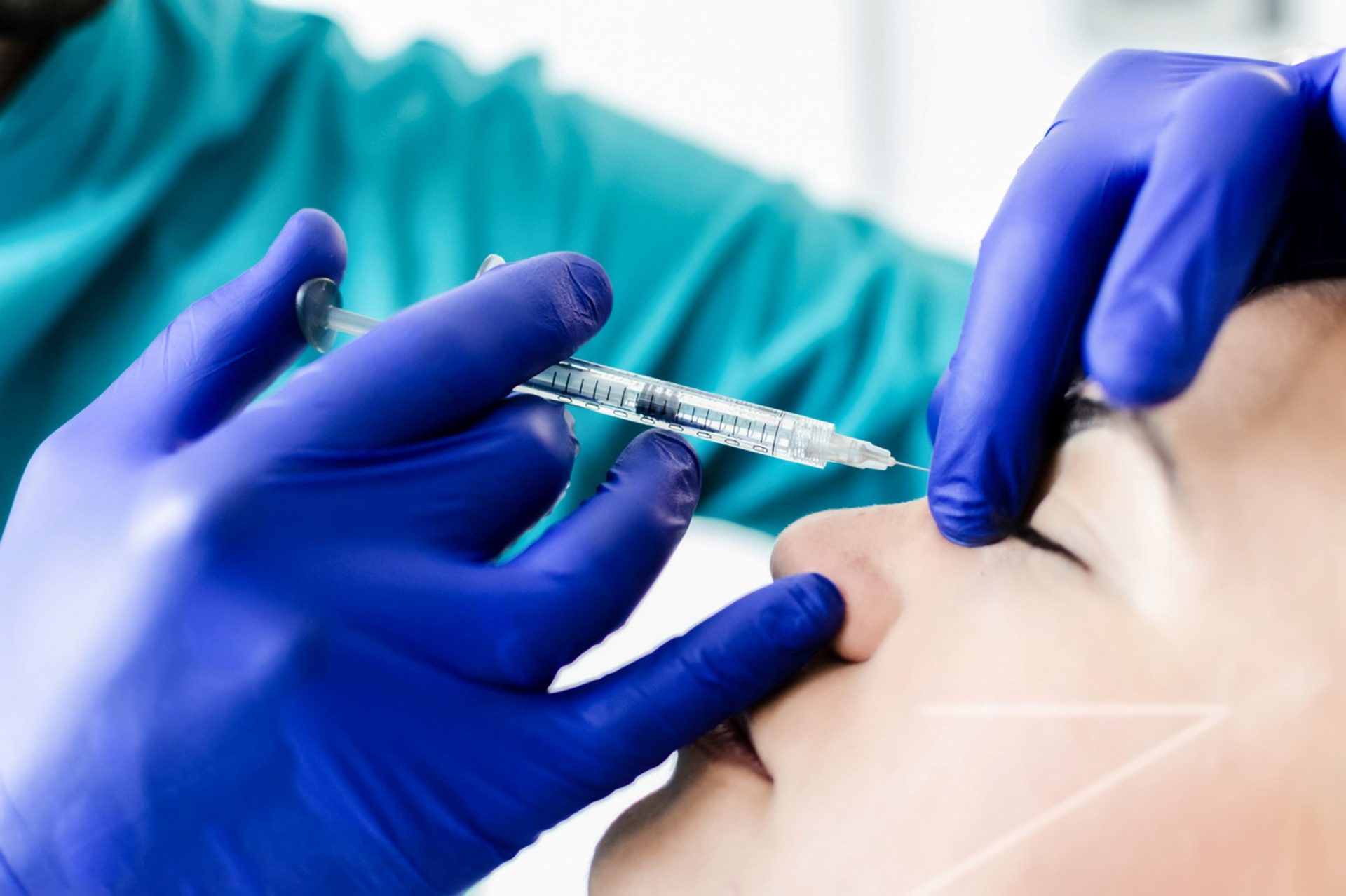
Filler Injection
It is a non-surgical treatment in which a filler material, like hyaluronic acid, is injected under the skin of the nose. The filler volumizes, sculpts and stimulates collagen production which, in turn, provides a temporary lift to the bridge and tip and can improve symmetry of the nose as well. Fillers are very malleable and can be used to enhance most nose profiles.
Korean Hiko Nose Thread Lift
HIKO Nose Threadlift is a highly popular minimally invasive procedure used to lift the nasal bridge and tip; and therefore, improves the overall shape of the nose. It involves the insertion of fine Polydioxanone (PDO) threads along the nasal bridge, and into the nose tip. These threads not only act as mechanical scaffolds and provide support but also induce the synthesis of collagen under the skin which further helps in rendering the desired lift to your nose.

Comparison Between Non-Surgical Nose Job And Surgical Nose Job
Here is a detailed comparison between surgical and non-surgical nose jobs;
Type Of Anesthesia Used
The non-surgical nose job is usually done under local anesthesia. In the case of surgical treatment, the choice of anesthesia is done based on the type and complexity of the rhinoplasty procedure. Mostly, general anesthesia is required.
Incisions
Dermal filler injection and HIKO nose thread lift are minimally invasive treatments and do not require any kind of incision. Instead, a small prick is created in the skin which heals completely in a few days without leaving any scar mark in the end.
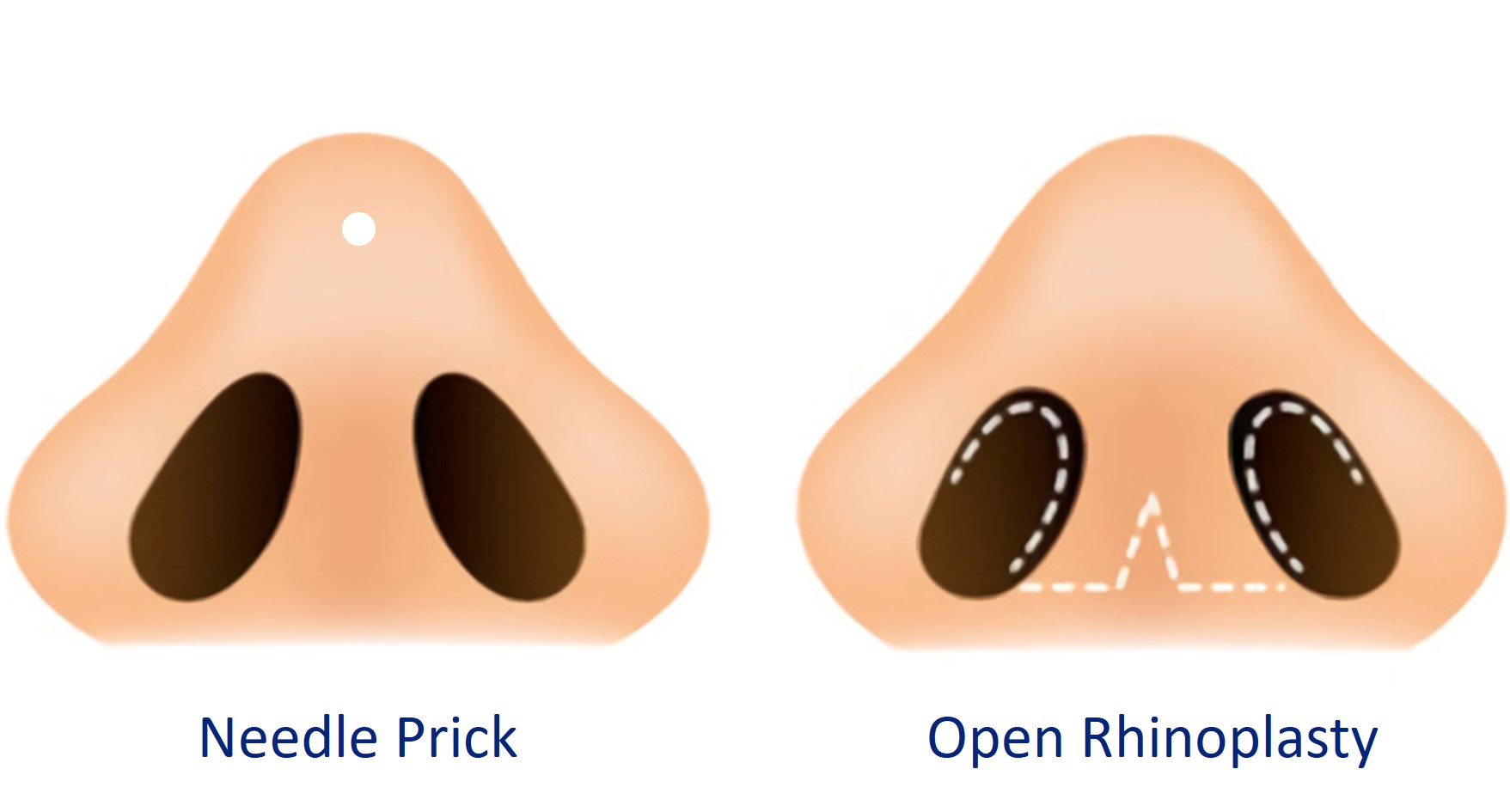
Rhinoplasty, however, do involve incisions and they are chosen based on the complexity of the procedure. The two common incision types are the closed and open approach. In a close approach, the incision is made within the nostrils. Whereas, in an open approach, incisions are made along the nostrils and across the columella.
Time Required For Procedure Completion
The time taken for a surgical nose job depends upon several factors. If it is revision surgery, or a medical rhinoplasty was done to correct the nose’s functions, or if the procedure is done by a less experienced surgeon, etc, it will take more time to complete. On average, rhinoplasty generally requires 1.5 to 3 hours for completion and is performed as an outpatient procedure.
On the other hand, a non-surgical nose job is usually done within 20 to 30 minutes. It is often referred to as a lunchtime procedure because it takes very little time to perform, and you can easily undergo the treatment during the lunch recess of your office.
Downtime
Non-surgical treatments, like dermal fillers and HIKO nose thread lift, have almost negligible downtime. You can get back to your normal routine soon after getting the treatment.
In comparison, you are kept under observation for some time after the rhinoplasty procedure to look for any immediate side effects and complications like post-operative bleeding, hemorrhage, etc. You are able to go home a couple of hours after the surgery with the accompaniment of a family member or friend. Operating of vehicles is not recommended as there may be residual anesthetic medication in the body.
Recovery Time
Non-surgical nose jobs have a very short recovery period, and usually requires a few hours or a day in most cases. Should there be swelling and bruising after treatment, it will take around 1 week to fade away completely.
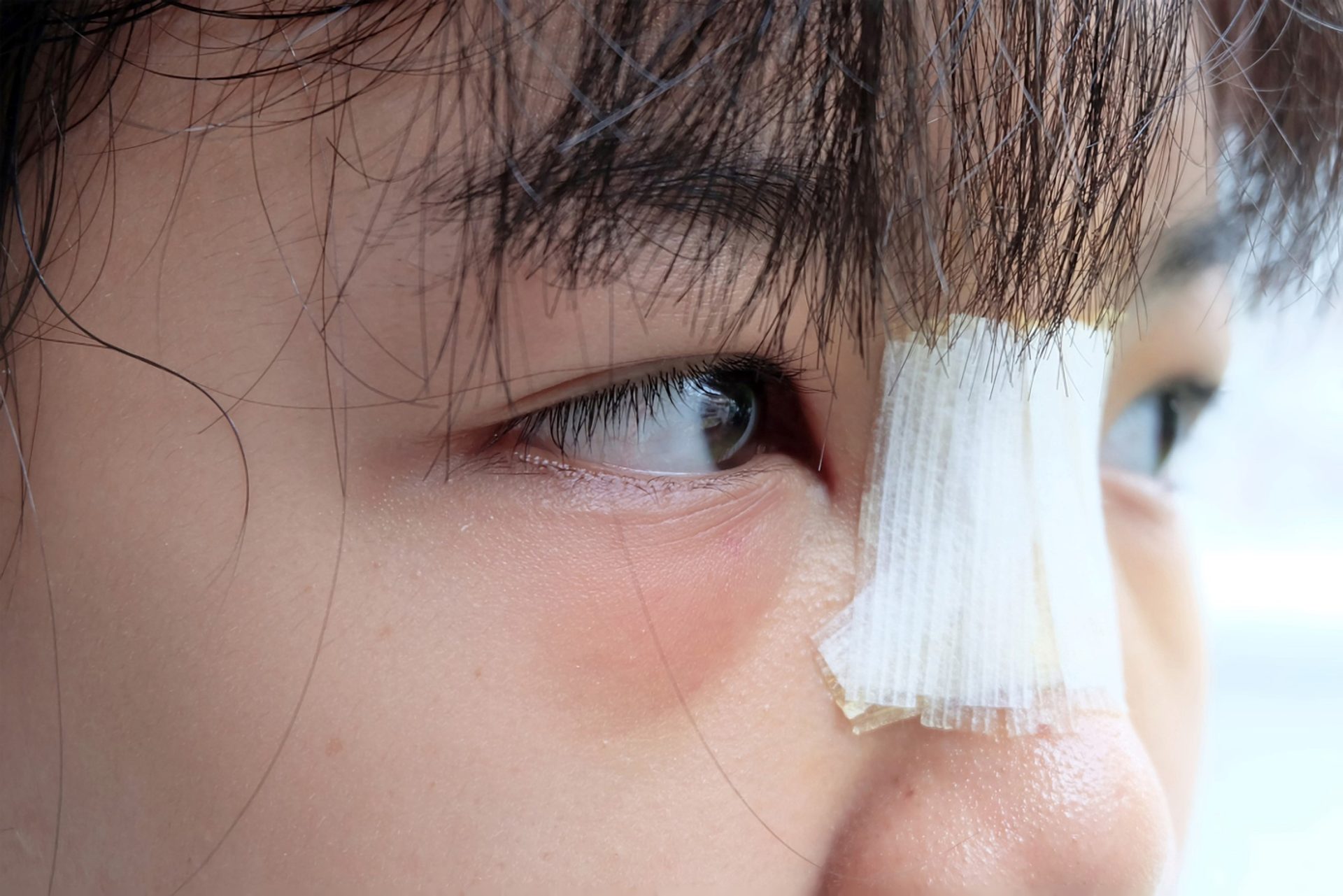
In the case of rhinoplasty, the recovery is quick in the beginning, and you can notice a significant reduction in swelling and bruising within 2 weeks. In the initial week of recovery, you will be required to take painkillers, antibiotics, and do cold compresses for faster recovery. Allocation of time to rest and recovery will help to reduce post-surgery anxiety due to time pressure. Besides, you have to wear a plastic splint during the first week to keep the nose in shape. Complete healing is slow and it may take up to 6 months before reviewing the final results. In short, a surgical nose job has a relatively long recovery period with more aftercare requirements.
Potential Risks Or Side Effects
As discussed earlier, a non-surgical nose job does not involve any kind of cutting or incision, so, it carries minimal risks of complications and side effects. There are no permanent scar marks, and there will be only mild swelling and bruising at the treatment sites which fade away in a few days.
Conversely, the greatest downside of surgical treatment is that with incisions, there is always possibility for mild which may take a longer time to fade away completely. Rhinoplasty is generally safe; however, the risks of side effects are higher given its surgical nature. You may experience swelling, bleeding (hematoma), bruising, wound infection, poor wound healing, numbness, or temporary loss of skin sensations around the treatment area. However, their incidence is very rare when done by a board-certified plastic surgeon.
Other side effects may be related to general anesthesia. These include nausea, vomiting, sore throat, etc.
Time Required For The Results To Appear
You can see improvements in the appearance of your nose immediately after getting the non-surgical nose job. In the case of surgical treatment, immediate improvements can be seen, but final results may take up to 6 months to finalize as a small percentage of the remnant swelling needs more time to subside totally.
Longevity Of Results
The results of a surgical nose job are permanent. However, it is not the case with filler injections or Korean HIKO nose thread lift treatments. You have to undergo the non-surgical nose jobs, repeatedly, because the results only last anywhere between 9 months to 1 year.
Price Comparison Of Non-Surgical And Surgical Nose Jobs
The surgical nose job’s cost in Singapore including the anesthesia and operating fees comes to be around $12000 to $16000. The non-surgical nose job, on the other hand, is cheaper and costs you around $600 to $1000.
When To Choose A Non-Surgical Nose Job
- If you don’t want to undergo surgery
- If you wish to see the results quickly
- If you are not sure about what will make your nose more attractive. Non-surgical nose jobs provide an opportunity to test the change because the results will fade away after some time, and if you are not happy, you can shift to other options.
- If you want to save money
- If you want to go for a treatment with fewer side effects and no scarring – etc
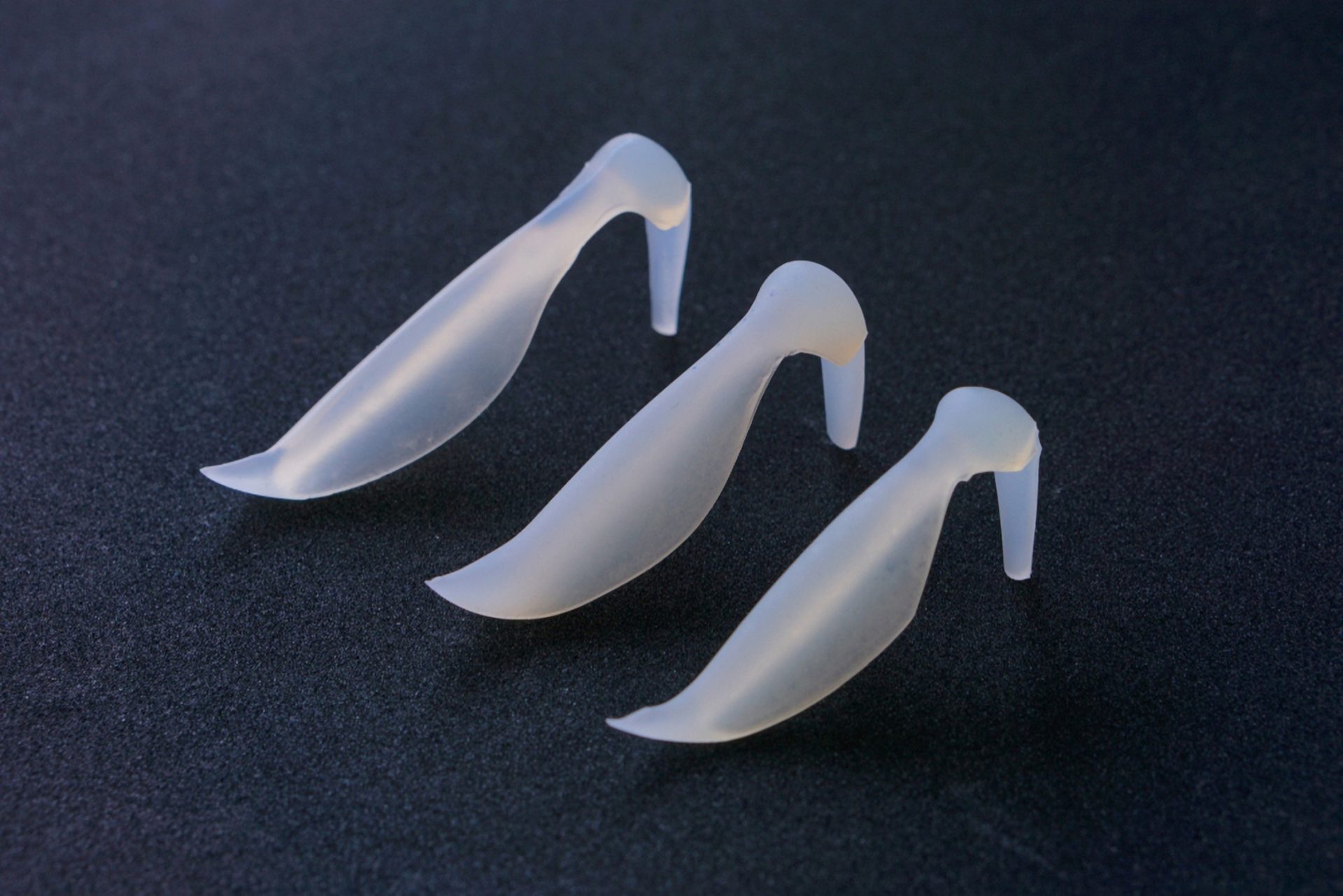
When To Consider Surgical Options
Here are a few indications of surgical nose jobs;
- If the non-surgical nose jobs fail to achieve the desired results.
- If you have nasal features like crooked, humped, wide nose, etc (mentioned above), that can be corrected only by surgery.
- If you have a condition that is interfering with normal functions of the nose, i.e. breathing.
- If you do not want to undergo repeated and maintenance sessions every year, and want a permanent treatment of your condition.
Bottom Line
Both surgical and non-surgical nose jobs have certain pros and cons. Although non-surgical nose jobs are cheaper and have quicker results, negligible downtime, faster recovery period, minimal risks of scarring and side effects, the results are not permanent and you have to undergo such treatments again and again to maintain the results. Rhinoplasty, on the other hand, provides a permanent solution and can be used to address more complicated issues. In the end, your preferences and condition determine which treatment option is best suitable for you.
About Dream Aesthetics and Plastic Surgery
Bespoke surgical for cosmetic or medical reasons is what Dream covers to bring out the beauty in every individual. Going beyond the aesthetics and working on physical anomalies are what we value the most in leading our patients to cherish self-improvement and confident lifestyles.
Derived from Associate Professor Vincent Yeow’s long-standing experience performing plastic surgery in Singapore, our treatment plans deliver physical remodelling in our patients’ favour. One of the notable remodellings is droopy eyelid correction. The ptosis surgery used for treatment eventually fixes drooping eyelids, improves vision and enhances appearance.
Most importantly, as a trustworthy plastic surgery and aesthetic clinic, we treasure positive and natural outcomes for each individual. We will ensure to deliver the beauty refinement of your dream without compromising your safety and privacy.



